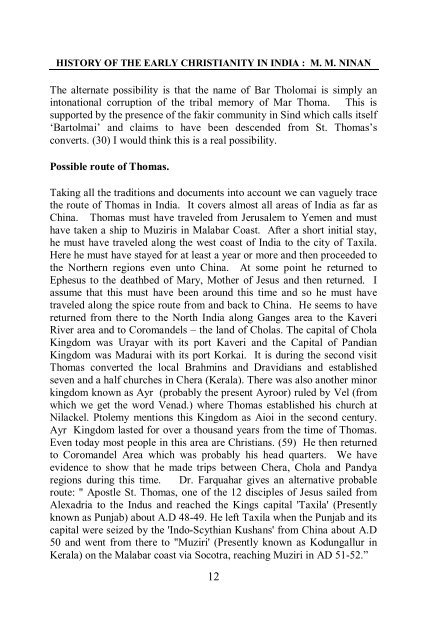History of Early Christianity in India
You also want an ePaper? Increase the reach of your titles
YUMPU automatically turns print PDFs into web optimized ePapers that Google loves.
HISTORY OF THE EARLY CHRISTIANITY IN INDIA : M. M. NINAN<br />
The alternate possibility is that the name <strong>of</strong> Bar Tholomai is simply an<br />
<strong>in</strong>tonational corruption <strong>of</strong> the tribal memory <strong>of</strong> Mar Thoma. This is<br />
supported by the presence <strong>of</strong> the fakir community <strong>in</strong> S<strong>in</strong>d which calls itself<br />
‘Bartolmai’ and claims to have been descended from St. Thomas’s<br />
converts. (30) I would th<strong>in</strong>k this is a real possibility.<br />
Possible route <strong>of</strong> Thomas.<br />
Tak<strong>in</strong>g all the traditions and documents <strong>in</strong>to account we can vaguely trace<br />
the route <strong>of</strong> Thomas <strong>in</strong> <strong>India</strong>. It covers almost all areas <strong>of</strong> <strong>India</strong> as far as<br />
Ch<strong>in</strong>a. Thomas must have traveled from Jerusalem to Yemen and must<br />
have taken a ship to Muziris <strong>in</strong> Malabar Coast. After a short <strong>in</strong>itial stay,<br />
he must have traveled along the west coast <strong>of</strong> <strong>India</strong> to the city <strong>of</strong> Taxila.<br />
Here he must have stayed for at least a year or more and then proceeded to<br />
the Northern regions even unto Ch<strong>in</strong>a. At some po<strong>in</strong>t he returned to<br />
Ephesus to the deathbed <strong>of</strong> Mary, Mother <strong>of</strong> Jesus and then returned. I<br />
assume that this must have been around this time and so he must have<br />
traveled along the spice route from and back to Ch<strong>in</strong>a. He seems to have<br />
returned from there to the North <strong>India</strong> along Ganges area to the Kaveri<br />
River area and to Coromandels – the land <strong>of</strong> Cholas. The capital <strong>of</strong> Chola<br />
K<strong>in</strong>gdom was Urayar with its port Kaveri and the Capital <strong>of</strong> Pandian<br />
K<strong>in</strong>gdom was Madurai with its port Korkai. It is dur<strong>in</strong>g the second visit<br />
Thomas converted the local Brahm<strong>in</strong>s and Dravidians and established<br />
seven and a half churches <strong>in</strong> Chera (Kerala). There was also another m<strong>in</strong>or<br />
k<strong>in</strong>gdom known as Ayr (probably the present Ayroor) ruled by Vel (from<br />
which we get the word Venad.) where Thomas established his church at<br />
Nilackel. Ptolemy mentions this K<strong>in</strong>gdom as Aioi <strong>in</strong> the second century.<br />
Ayr K<strong>in</strong>gdom lasted for over a thousand years from the time <strong>of</strong> Thomas.<br />
Even today most people <strong>in</strong> this area are Christians. (59) He then returned<br />
to Coromandel Area which was probably his head quarters. We have<br />
evidence to show that he made trips between Chera, Chola and Pandya<br />
regions dur<strong>in</strong>g this time. Dr. Farquahar gives an alternative probable<br />
route: " Apostle St. Thomas, one <strong>of</strong> the 12 disciples <strong>of</strong> Jesus sailed from<br />
Alexadria to the Indus and reached the K<strong>in</strong>gs capital 'Taxila' (Presently<br />
known as Punjab) about A.D 48-49. He left Taxila when the Punjab and its<br />
capital were seized by the 'Indo-Scythian Kushans' from Ch<strong>in</strong>a about A.D<br />
50 and went from there to "Muziri' (Presently known as Kodungallur <strong>in</strong><br />
Kerala) on the Malabar coast via Socotra, reach<strong>in</strong>g Muziri <strong>in</strong> AD 51-52.”<br />
12


















